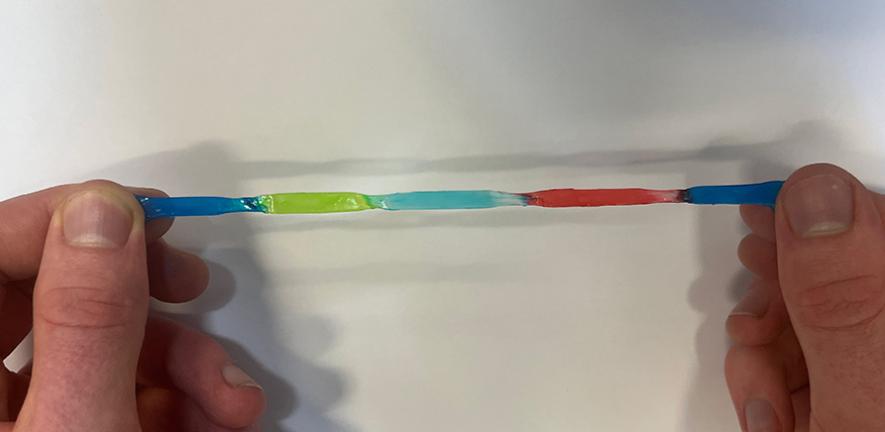Soft, stretchy ‘jelly batteries’ inspired by electric eels
剑桥大学研究人员开发出一种柔软可拉伸的“果冻电池”,适用于可穿戴设备或软体机器人,甚至可以植入大脑以输送药物或治疗癫痫等疾病。
Researchers have developed soft, stretchable ‘jelly batteries’ that could be used for wearable devices or soft robotics, or even implanted in the brain to deliver drugs or treat conditions such as epilepsy.

剑桥大学的研究人员受电鳗启发,电鳗会用名为“发电细胞”的改良肌肉细胞击晕猎物。
The researchers, from the University of Cambridge, took their inspiration from electric eels, which stun their prey with modified muscle cells called electrocytes.
像发电细胞一样,剑桥研究人员开发的果冻状电池,具有分层结构,就像粘在一起的乐高一样,能够有效输送电流。
Like electrocytes, the jelly-like materials developed by the Cambridge researchers have a layered structure, like sticky Lego, that makes them capable of delivering an electric current.
这种可自我修复的“果冻电池”能拉伸到原长度的十倍以上,而不会影响其导电性,这是第一次在一种材料中同时实现可拉伸性和导电性。相关研究结果已发表在期刊《科学进展》(Science Advances)上。
The self-healing jelly batteries can stretch to over ten times their original length without affecting their conductivity – the first time that such stretchability and conductivity has been combined in a single material. The results are reported in the journal Science Advances.
“果冻电池”由水凝胶制成,水凝胶是含水量超60%的高分子聚合物形成的3D网状结构。聚合物们通过可逆的开/关相互作用结合在一起,从而控制果冻的机械特性。
The jelly batteries are made from hydrogels: 3D networks of polymers that contain over 60% water. The polymers are held together by reversible on/off interactions that control the jelly’s mechanical properties.
水凝胶可以精确控制机械性能和模仿人体组织特征的能力,使其成为软体机器人和生物电子学的理想材料。然而,对于此类应用,材料需要兼具导电性和可拉伸性。
The ability to precisely control mechanical properties and mimic the characteristics of human tissue makes hydrogels ideal candidates for soft robotics and bioelectronics; however, they need to be both conductive and stretchy for such applications.
来自剑桥大学化学系的第一作者Stephen O’Neill表示:“要设计出一种既具有高度可拉伸性又具有高导电性能的材料非常困难,因为这两种特性通常互不兼容。通常,材料拉伸时导电性会下降。”
“It’s difficult to design a material that is both highly stretchable and highly conductive, since those two properties are normally at odds with one another,” said first author Stephen O’Neill, from Cambridge’s Yusuf Hamied Department of Chemistry. “Typically, conductivity decreases when a material is stretched.”
该论文的共同作者、化学系的Jade McCune博士表示:“一般情况下,水凝胶是由电中性的聚合物制成的,但如果我们给它们充电,它们就能导电。通过改变每块凝胶中的盐成分,可以使它们变得粘稠,再通过挤压使其形成多层结构,从而可以形成更强的导电性能。”
“Normally, hydrogels are made of polymers that have a neutral charge, but if we charge them, they can become conductive,” said co-author Dr Jade McCune, also from the Department of Chemistry. “And by changing the salt component of each gel, we can make them sticky and squish them together in multiple layers, so we can build up a larger energy potential.”
传统电子产品使用刚性金属材料,以电子作为电荷载体,而“果冻电池”则像电鳗一样使用离子来携带电荷。
Conventional electronics use rigid metallic materials with electrons as charge carriers, while the jelly batteries use ions to carry charge, like electric eels.
水凝胶之所以能牢固地粘在一起,是因为不同层之间形成的可逆键。该过程中使用了桶状分子——葫芦脲,它们就像“分子手铐”一样。“分子手铐”提供的层间强黏合力使“果冻电池”可以被拉伸,却不会导致层间分离,关键是导电性不会有任何损失。
The hydrogels stick strongly to each other because of reversible bonds that can form between the different layers, using barrel-shaped molecules called cucurbiturils that are like molecular handcuffs. The strong adhesion between layers provided by the molecular handcuffs allows for the jelly batteries to be stretched, without the layers coming apart and crucially, without any loss of conductivity.
由于“果冻电池”质地柔软,可与人体组织紧密贴合,这种特性使其有望在未来用于生物医学植入物。梅尔维尔高分子聚合物合成实验室(Melville Laboratory for Polymer Synthesis)主任Oren Scherman教授表示:“我们可以定制化水凝胶的机械性能,使其与人体组织匹配。由于它们不含金属等刚性成分,因此水凝胶植入物不太可能被人体排斥或导致疤痕组织堆积。”Scherman教授与工程系的George Malliaras教授合作领导了这项研究。
The properties of the jelly batteries make them promising for future use in biomedical implants, since they are soft and mould to human tissue. “We can customise the mechanical properties of the hydrogels so they match human tissue,” said Professor Oren Scherman, Director of the Melville Laboratory for Polymer Synthesis, who led the research in collaboration with Professor George Malliaras from the Department of Engineering. “Since they contain no rigid components such as metal, a hydrogel implant would be much less likely to be rejected by the body or cause the build-up of scar tissue.”
除了柔软,水凝胶还具有惊人的韧性,可以承受压力而不变形,受损时还能自行修复。
In addition to their softness, the hydrogels are also surprisingly tough. They can withstand being squashed without permanently losing their original shape, and can self-heal when damaged.
研究人员正计划未来在实验中用活体来测试这种“果冻电池”,以评估其在一系列医疗应用中的适用性。
The researchers are planning future experiments to test the hydrogels in living organisms to assess their suitability for a range of medical applications.
这项研究得到了欧洲研究委员会和英国国家科研与创新署(UKRI)旗下的工程与自然科学研究(EPSRC)的资助。Oren Scherman是剑桥大学耶稣学院的教员。
The research was funded by the European Research Council and the Engineering and Physical Sciences Research Council (EPSRC), part of UK Research and Innovation (UKRI). Oren Scherman is a Fellow of Jesus College, Cambridge.

 中文
中文 English
English
